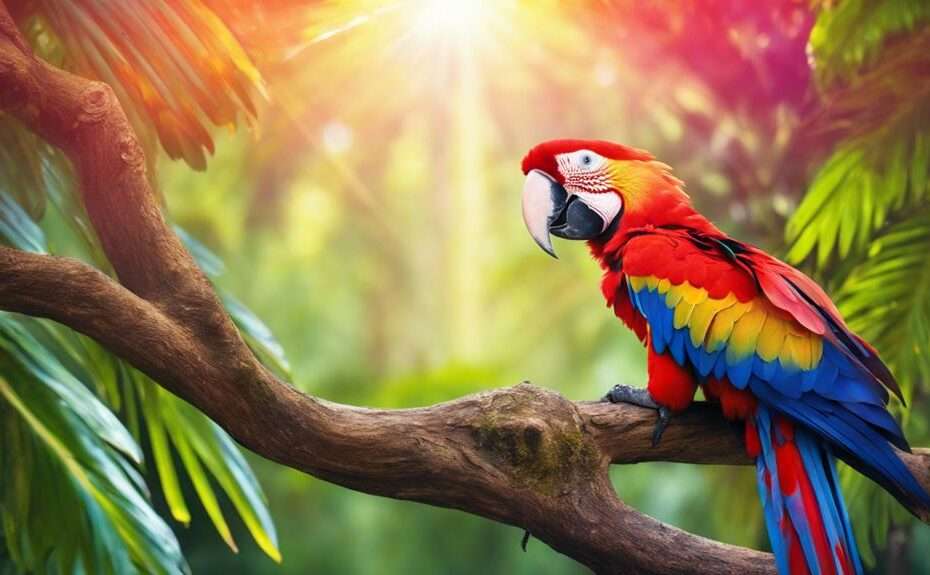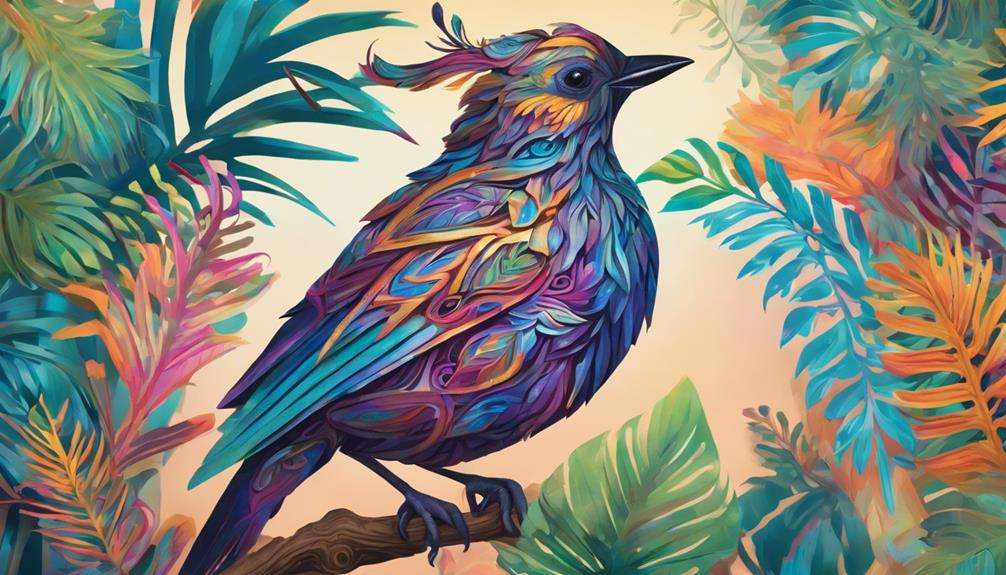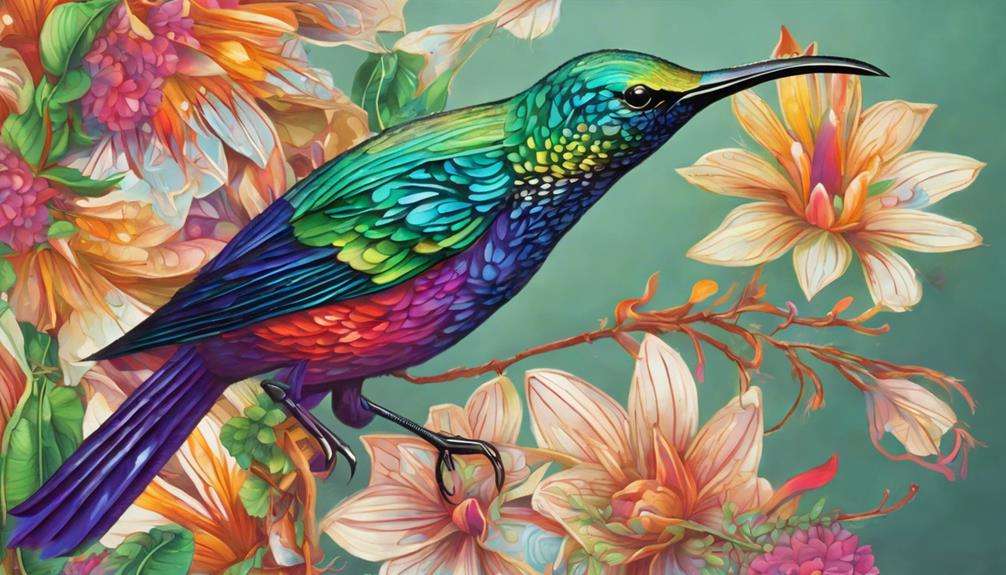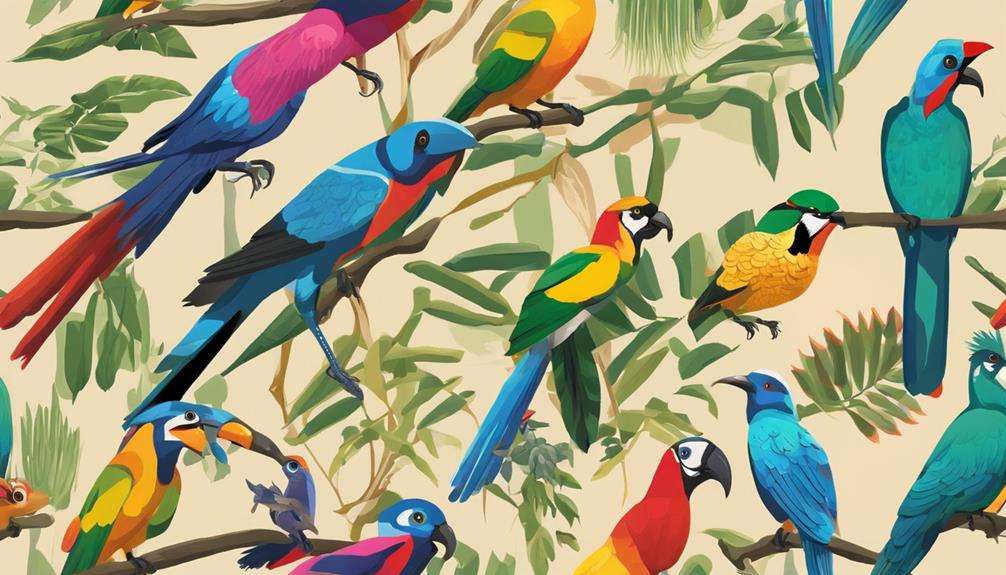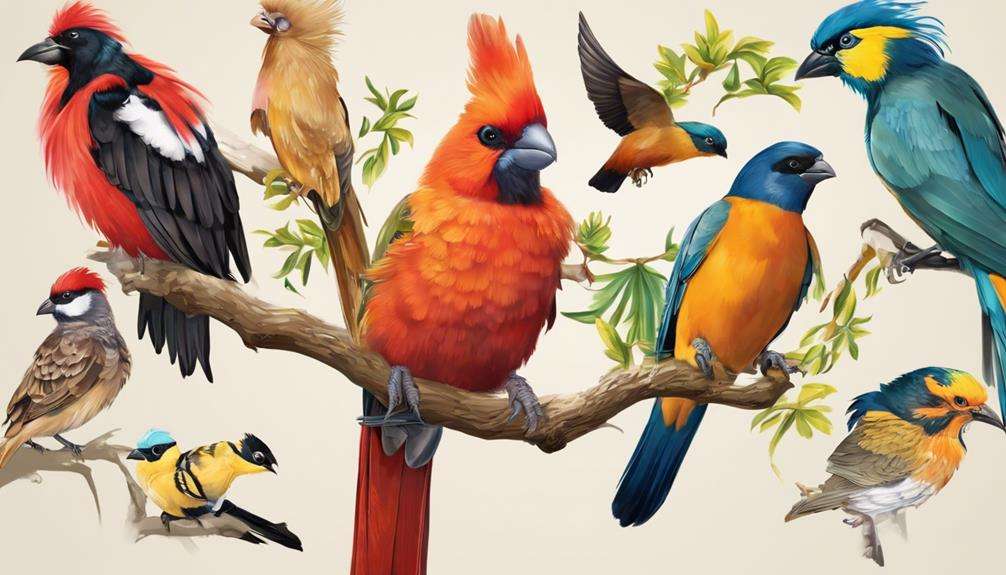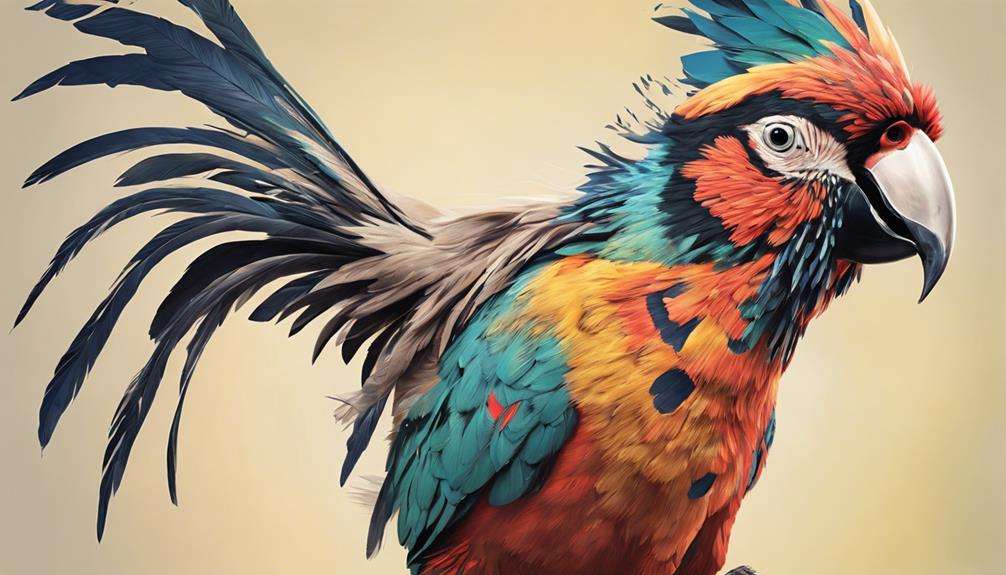For bird enthusiasts seeking alluring species to observe, consider the exotic Manakin with its energetic displays and unique sounds. These birds are known for their fascinating courtship rituals and vibrant plumage.
The Manakin's intricate behaviors and colorful appearance make them a must-see for any avian enthusiast looking to expand their knowledge of diverse bird species.
Explore further to uncover the secrets behind this mesmerizing bird and its intriguing way of life.
Key Takeaways
- Bowerbirds showcase intricate courtship displays with vibrant colors and artistic bowers.
- Unique bird species like the Bee Hummingbird and Emerald Toucanet captivate with their size and colorful plumage.
- Kiwi birds and Tufted Puffins exhibit distinctive behaviors and adaptations in their habitats.
- Magellanic Woodpeckers and Red-knobbed Hornbills impress with their physical features and ecological roles.
Exotic Manakin Bird Species
The Exotic Manakin Bird Species captivates enthusiasts with their unique courtship behaviors and mesmerizing displays in the rainforests of Central and South America. These birds, known for their vibrant colors and intricate dances, showcase an array of fascinating courtship rituals that set them apart from other avian species.
Manakins are renowned for creating buzzing sounds akin to violins by vibrating their feathers and clacking their wings, adding a musical element to their performances. Despite their solid wing bones that make them somewhat clumsy fliers, these specialized bones support their vigorous dancing displays, allowing them to excel in intricate mating dances.
In the lush rainforest habitats where they can be found, manakins engage in elaborate choreography and intricate displays to attract potential mates. Their courtship rituals involve synchronized movements, acrobatics, and vocalizations that create a mesmerizing spectacle for any observer lucky enough to witness these exotic birds in action. The courtship behaviors of manakins truly showcase the wonders of nature's creativity and beauty.
Unique Bowerbird Species
Male bowerbirds meticulously construct elaborate bowers, using a diverse array of colorful materials like flowers, berries, feathers, and even man-made objects to attract potential mates.
These intricate displays serve as arenas for their courtship rituals, showcasing the bowerbirds' artistic and creative abilities.
Bowerbird's Intricate Displays
With meticulous care and precision, bowerbirds construct elaborate sculptures known as bowers to entice potential mates for reproduction. These avian artisans meticulously adorn their bowers with a diverse array of decorations, including vibrant flowers, intricate feathers, shiny shells, and even items crafted by humans.
The bowerbirds' artistic skills are showcased in the thoughtful arrangement and rearrangement of these ornaments, highlighting their dedication to attracting a mate. These courtship displays aren't just about showing off but also about maintaining the allure of their bowers.
Found in regions like Australia and New Guinea, bowerbirds' unique behavior exemplifies avian ingenuity and aesthetic sensibility, making them a fascinating subject for enthusiasts interested in the fascinating world of bird courtship rituals.
Mating Rituals of Bowerbirds
Exhibiting intricate behaviors unique to their species, Bowerbirds engage in elaborate mating rituals centered around the construction and decoration of bowers. Male bowerbirds meticulously build and decorate bowers to attract potential mates. These structures are adorned with colorful and shiny objects such as flowers, berries, shells, and even human-made items.
The bowerbirds' courtship ritual involves the careful arrangement and maintenance of these bowers, with males often rearranging objects and tidying up the surroundings. Through these unique mating displays, bowerbirds showcase their creativity, aesthetic sense, and dedication to impressing and attracting a mate.
The elaborate process of bower construction and decoration highlights the bowerbirds' commitment to courtship and the importance of their displays in the mating process.
Unique Bowerbird Nest-Building
Observing the intricate nest-building behaviors of unique bowerbird species provides insight into their remarkable adaptability and architectural skills in creating elaborate structures to attract mates. Male bowerbirds meticulously construct bowers, which serve as elaborate display areas for courtship rituals.
These bowers are adorned with a variety of colorful and unique objects such as shells, feathers, and flowers, showcasing the male's creativity and resourcefulness. The bowerbirds constantly rearrange and maintain their bowers, ensuring they're in pristine condition to impress potential mates.
Surprisingly, some bowerbird species have been observed incorporating human-made items like plastic and glass into their bowers, demonstrating their ability to adapt to changing environments while still adhering to their courtship traditions.
Rare Bee Hummingbird Species
The Rare Bee Hummingbird species, the smallest bird globally, is mainly found in Cuba and surrounding islands. These diminutive creatures exhibit a remarkable feat by consuming up to half their body weight in food daily to sustain their exceptionally high metabolism. Despite their tiny size, Bee Hummingbirds play an important role in pollinating numerous flowers daily, aiding in the reproduction of various plant species. However, these tiny birds face threats from predators like invertebrates, particularly spiders that pose a danger to their existence.
Due to their small stature and rapid metabolism, Bee Hummingbirds are particularly vulnerable to environmental changes and habitat loss. Conservation efforts are essential to ensuring the survival of these fascinating creatures, as they aren't only a wonder of nature but also contribute significantly to the ecosystem through their pollination activities. Observing these rare and delicate beings in their natural habitat is a privilege for bird enthusiasts, showcasing the intricate balance of nature in which they play an important part.
Fascinating Emerald Toucanet Bird
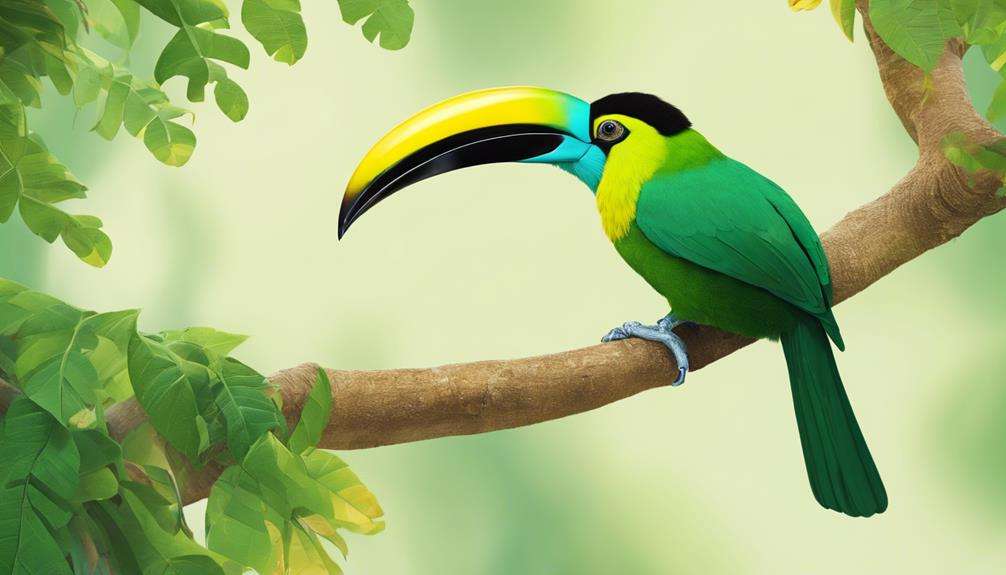
You gaze upon the enchanting emerald toucanet, marveling at its vibrant green feathers that shimmer in the sunlight. Its unique bill shape catches your eye, perfectly adapted for grasping and carrying fruit during intricate mating rituals.
Observing these birds in their natural habitat reveals their playful courtship behavior and adds a colorful presence to the lush rainforests of Central and South America.
Colorful Plumage Features
With iridescent green feathers shimmering in the sunlight, the intriguing Emerald Toucanet bird displays enchanting colorful plumage features. Native to Central and South America, these miniature toucans are renowned for their vibrant plumage, which adds a splash of emerald brilliance to the lush green canopies they inhabit.
The striking contrast between their glossy green feathers and the dark markings on their bodies makes them stand out in the dense foliage. Observing them in their natural habitat is a treat for bird enthusiasts, as they flutter gracefully among the trees, their plumage catching the light in a mesmerizing dance of colors.
The Emerald Toucanet's unique behaviors, such as their playful fruit-tossing game during mating rituals, further add to their charm and allure.
Unique Bill Shape
Featuring a bill uniquely shaped for grasping and manipulating various food items, the Fascinating Emerald Toucanet Bird exhibits a remarkable adaptation for its specialized feeding behaviors in the rainforest. This avian species showcases a distinctive bill structure with a chromatic beak that aids in its foraging activities.
The toucanet's bill is specifically designed to handle fruits, seeds, and small prey, highlighting its unique characteristics within the bird world. In nature, toucanets utilize their bills to pluck fruits from branches and even toss them during courtship displays, showcasing the essential importance of this specialized feature.
This specialized bill shape is essential for the Emerald Toucanet's survival and reproductive success, emphasizing the significance of adaptations in avian species for thriving in their habitats.
Habitat and Behavior
The habitat of the Fascinating Emerald Toucanet Bird consists of lush rainforests in Central and South America, where its vibrant plumage and unique behaviors add to its enthralling allure for bird enthusiasts.
These miniature toucans sport iridescent green feathers, enhancing their striking appearance. During mating rituals, Emerald Toucanets showcase playful behavior by gathering fruit in their bills and engaging in a fruit-tossing game. This behavior not only serves as a mating display but also demonstrates their playful nature.
The combination of their colorful features and engaging behaviors makes the Emerald Toucanet a captivating species to observe in its natural habitat. The lush rainforests of Central and South America provide the perfect backdrop for these enchanting birds to display their vibrant plumage and entertaining antics.
Enigmatic Kiwi Birds
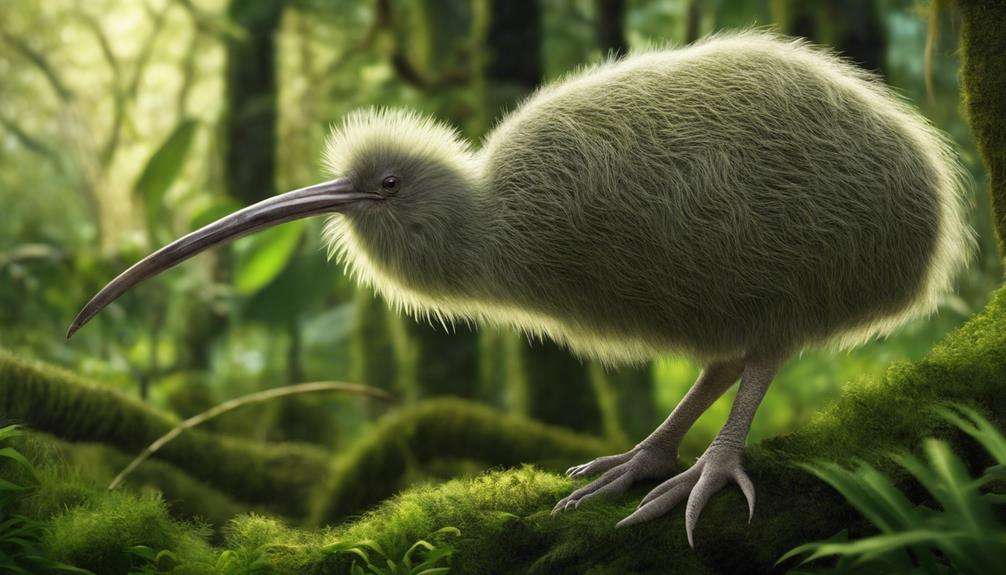
Nestled in the dense forests of New Zealand, the enigmatic Kiwi birds captivate with their unique adaptations and behaviors. These flightless birds have robust legs well-suited for digging, as flying isn't part of their skill set. Their feathers serve more for insulation and protection rather than aiding in flight, showcasing their specialized evolution. Endemic to New Zealand, Kiwi birds rely heavily on their extraordinary sense of smell to forage for food, a trait that sets them apart from many other bird species.
However, despite their remarkable abilities, Kiwi birds face significant threats from poaching and predators, endangering their populations. The longevity of these birds, with lifespans ranging from 60 to 90 years, highlights their resilience in the face of these challenges. As stewards of their unique habitats, it's essential to protect these fascinating creatures to make sure they continue to roam the forests of New Zealand for generations to come.
Alluring Tufted Puffin Species
In the remote, treeless islands of the Pacific Ocean, the enticing Tufted Puffin species showcases its bright orange bills and distinctive white ear tufts, enchanting observers with its unique characteristics and behaviors. Tufted puffins, with their striking appearance, are known for their diet primarily consisting of small fish and invertebrates. These birds exhibit remarkable agility in the air, flapping their wings at an incredible rate of approximately 400 times per minute as they navigate their oceanic habitat.
Living in colonies, tufted puffins engage in fascinating social behaviors. They can be observed interacting with one another, particularly during the breeding season when their colonies become bustling hubs of activity. The white ear tufts, bright orange bills, and black plumage of the tufted puffins create a charming sight against the backdrop of the Pacific Ocean islands where they reside. Observing these birds in their natural habitat provides a glimpse into the intricate and interconnected lives of these enticing seabirds.
Intriguing Magellanic Woodpecker
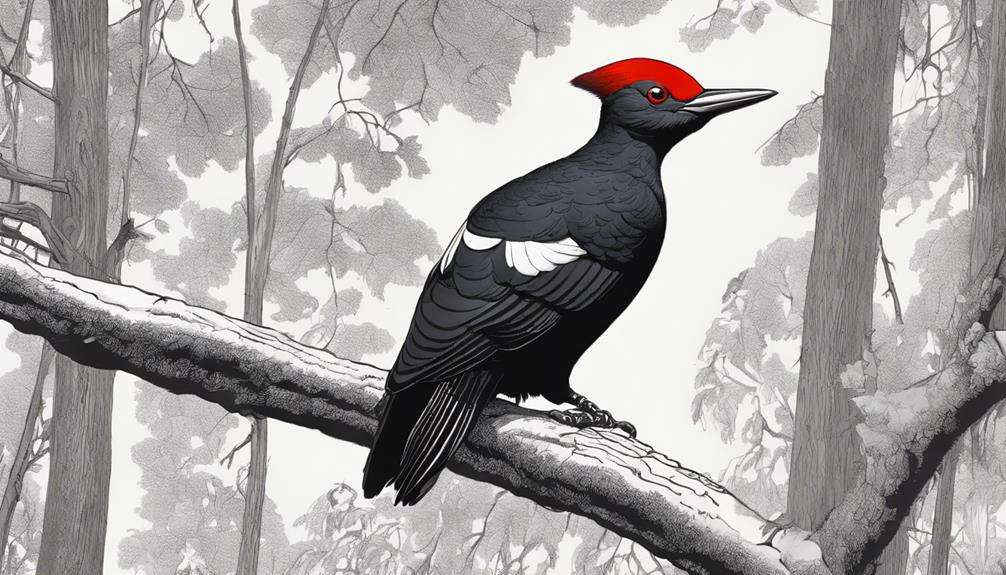
Amidst the dense forests of southern Chile and Argentina, the impressive Magellanic Woodpecker stands out with its striking black-and-white plumage and powerful beak. As the largest woodpecker species in South America, the Magellanic Woodpecker's presence is commanding. This woodpecker's habitat choice of dense forests provides ample opportunities for nesting and foraging. Known for its territorial behavior, it fiercely defends its space, often communicating through distinctive vocalizations.
The Magellanic Woodpecker's black-and-white plumage not only serves as a visually striking feature but also aids in camouflage within the forested environment. Its powerful beak is a versatile tool, allowing it to drum on trees for food and to establish its territory. This woodpecker's foraging techniques are efficient, showcasing its adaptability and survival skills in its natural habitat. The combination of its size, plumage, territorial behavior, and powerful beak makes the Magellanic Woodpecker a captivating bird species for enthusiasts seeking to witness the wonders of South American avifauna.
Captivating Red-knobbed Hornbill Bird
With its distinctive crimson knob adorning its beak, the Red-knobbed Hornbill bird of Indonesia captures attention with its unique physical characteristics. These birds, native to Indonesia, stand out with their black feathers and the striking red knob on their beaks.
Red-knobbed Hornbills are essential for seed dispersal in their habitat due to their frugivorous diet. Their boisterous vocalizations, amplified by their large casques, reverberate through the dense Indonesian forests, adding to their allure.
Found mainly in the lush forests of Sulawesi, these alluring birds not only showcase their striking appearance but also play a significant ecological role. Observing the Red-knobbed Hornbill in its natural habitat offers enthusiasts a glimpse into the fascinating world of avian diversity and the intricate relationships between these birds and their environment in Indonesia.
Frequently Asked Questions
What Is a Bird Enthusiast Called?
You're an avian admirer, known as an ornithophile. Your passion lies in studying feathered friends, engaging in birdwatching, and contributing to avifauna appreciation. Embrace the beauty of bird species and connect with like-minded individuals.
What's the Coolest Bird?
When you consider the coolest bird, the peacock's colorful plumage, unique courtship dances, and impressive vocalizations make it a standout choice. Their acrobatic flights and fascinating migrations further enhance their alluring allure for bird enthusiasts.
Which Bird Is an Inspiration?
When seeking an avian wonder, look to the Kakapo. These beaked beauties, with intricate feathered companions, embody sky-bound inspiration. Their unique adaptations and role in ecosystems make them flighted muses, deserving admiration for their resilience and beauty.
What Is the Most Affectionate Bird Species?
When it comes to the most affectionate bird species, friendly cockatoos steal the spotlight. These cuddly lovebirds, like the Sulphur-Crested Cockatoo, excel in expressing emotions. Their sociable nature and crest-raising antics make them a top choice for companionship.
Conclusion
As you continue to explore the alluring world of bird species, you'll be drawn deeper into the intricate lives of these fascinating creatures. From the energetic Manakins to the artistic Bowerbirds, each species offers a unique glimpse into the diversity of avian life.
Stay tuned for more discoveries as you uncover the secrets and wonders of these alluring birds. The world of bird enthusiasts is full of surprises waiting to be uncovered.
